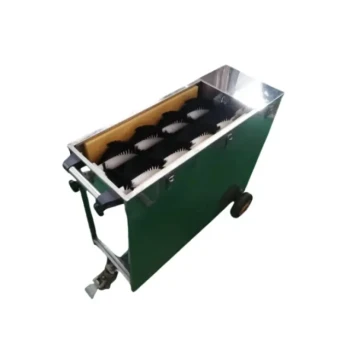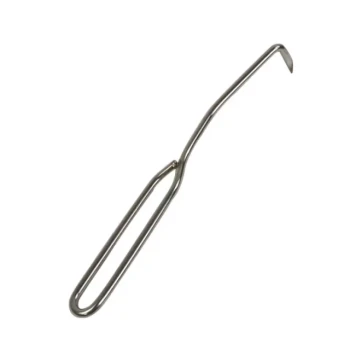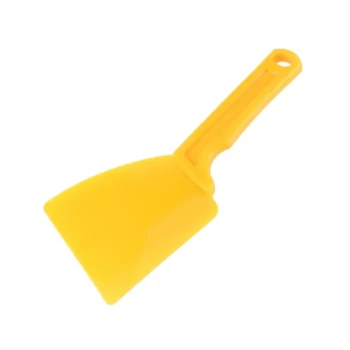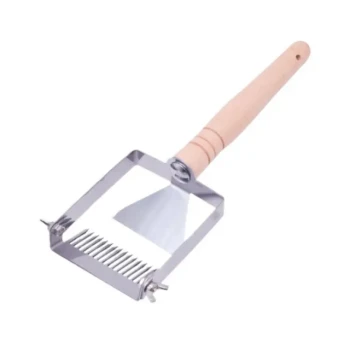Finding an ant nest near your beehive requires a measured response focused on bee safety. While directly treating the nest with a bee-safe substance like food-grade diatomaceous earth is a common action, it should be part of a larger, more strategic approach to hive protection.
The goal is not simply to eliminate one ant nest, but to create a defensible space that protects your bees from current and future invasions. The most effective strategies focus on prevention and physical barriers, resorting to direct nest treatments only when necessary and with extreme care.
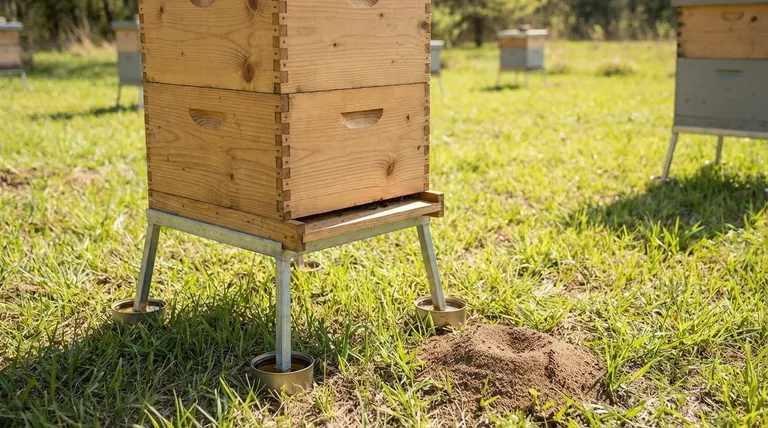
First, Assess the Threat Level
Before taking any action, it's critical to understand the nature of the problem. Not all ants pose an immediate, severe threat to a healthy honey bee colony.
Is the Colony Strong or Weak?
A strong, populous hive has a robust guard force. They can often defend their entrance from a small number of scout ants, preventing a full-scale invasion before it begins. A weaker or smaller colony is far more vulnerable.
Observe the Ant Behavior
Are you seeing a few ants wandering near the hive, or is there an established, consistent trail of ants marching to and from the hive entrance? A dedicated trail indicates they have found a food source (honey, brood, or syrup) and are actively raiding the colony. This requires immediate intervention.
Creating a Bee-Safe Defense Zone
The most reliable way to handle ants is to make the hive itself an unattractive and inaccessible target. Prevention is always superior to reaction.
Elevate Your Hive
Placing your hive directly on the ground is an open invitation for pests. Use a hive stand to elevate the colony at least 18 inches. This creates a significant physical barrier and makes it harder for ants to find their way in.
Utilize Hive Stand Moats
This is one of the most effective non-toxic methods. Place each leg of your hive stand in a can or container filled with a substance ants cannot cross, such as:
- Vegetable oil or mineral oil
- Soapy water
Be sure to clean and refill these moats regularly, as they can become bridged by debris like grass or leaves.
Maintain a Clean Apiary
Ants are scavengers attracted to easy meals. Keep the area around your hives meticulously clean. Promptly clean up any spilled syrup or honey, and remove dead bees from in front of the hive to avoid attracting opportunistic ants.
Directly Addressing the Ant Nest
If preventative measures are not enough and the nest poses a clear threat, you can act on it directly. Your priority must be to use methods that will not harm your bees.
Use Food-Grade Diatomaceous Earth (DE)
Diatomaceous earth is a natural, abrasive powder that works by scratching the ants' exoskeletons, causing them to dehydrate. Apply the powder directly onto and around the ant nest, not on the hive itself. Do this on a calm day to prevent the dust from blowing towards the hive entrance, as it can be harmful to bees if they inhale it.
Apply Boiling Water
For nests located a safe distance from your hive, a simple kettle of boiling water can be a highly effective and chemical-free solution. Pouring it directly into the nest entrance will eliminate a significant portion of the colony instantly without leaving any toxic residue.
Use Cinnamon as a Deterrent
Ground cinnamon is a strong ant deterrent. You can create a physical barrier by sprinkling a thick line of cinnamon powder on the ground around the legs of your hive stand. Ants are highly reluctant to cross it.
Common Pitfalls to Avoid
In your effort to protect your hive, it's easy to make mistakes that could cause more harm than good.
Never Use Conventional Pesticides
Do not use liquid ant killers, baits, or broad-spectrum insecticide sprays anywhere near your apiary. These products are highly toxic to bees. Even if you apply them far from the hive, bees can forage on treated plants or encounter the poison, leading to catastrophic colony losses.
Be Cautious with Powders
Even bee-safe powders like diatomaceous earth should be used with care. Never apply them in a way that allows them to drift into the hive or onto the landing board. These fine particles can harm bee larvae and interfere with the adult bees' ability to breathe.
Making the Right Choice for Your Goal
Your response should be tailored to the severity of the ant pressure on your colony.
- If your primary focus is long-term prevention: Elevate your hives on stands and place the legs in oil-filled moats.
- If your primary focus is stopping a minor incursion: Create a physical barrier around the hive stand legs with cinnamon or diatomaceous earth and clean the apiary thoroughly.
- If your primary focus is eliminating an active, threatening nest: Carefully apply diatomaceous earth or boiling water directly to the nest, ensuring no contaminants can reach your bees.
Proactive management and a layered defense are the keys to keeping your bees safe from ants.
Summary Table:
| Action | Best For | Key Consideration |
|---|---|---|
| Elevate Hive + Oil Moats | Long-term prevention | Creates a physical barrier; most effective strategy. |
| Cinnamon / Diatomaceous Earth Barrier | Minor incursions | Creates a deterrent ring around hive stand legs. |
| Boiling Water on Nest | Eliminating a threatening nest | Use only if the nest is a safe distance from the hive. |
| Food-Grade Diatomaceous Earth on Nest | Eliminating a threatening nest | Apply on a calm day to avoid drift towards the hive. |
Protect Your Apiary with Professional-Grade Equipment
Is your beekeeping operation threatened by pests like ants? A strong defense starts with reliable, well-designed equipment. HONESTBEE supplies commercial apiaries and beekeeping equipment distributors with the durable, wholesale-focused supplies needed to build a resilient apiary.
We provide the essential tools for effective hive management and pest prevention, helping you safeguard your investment and ensure colony health.
Ready to fortify your beekeeping operation? Contact our team today to discuss your wholesale equipment needs and discover how HONESTBEE can support your success.
Visual Guide
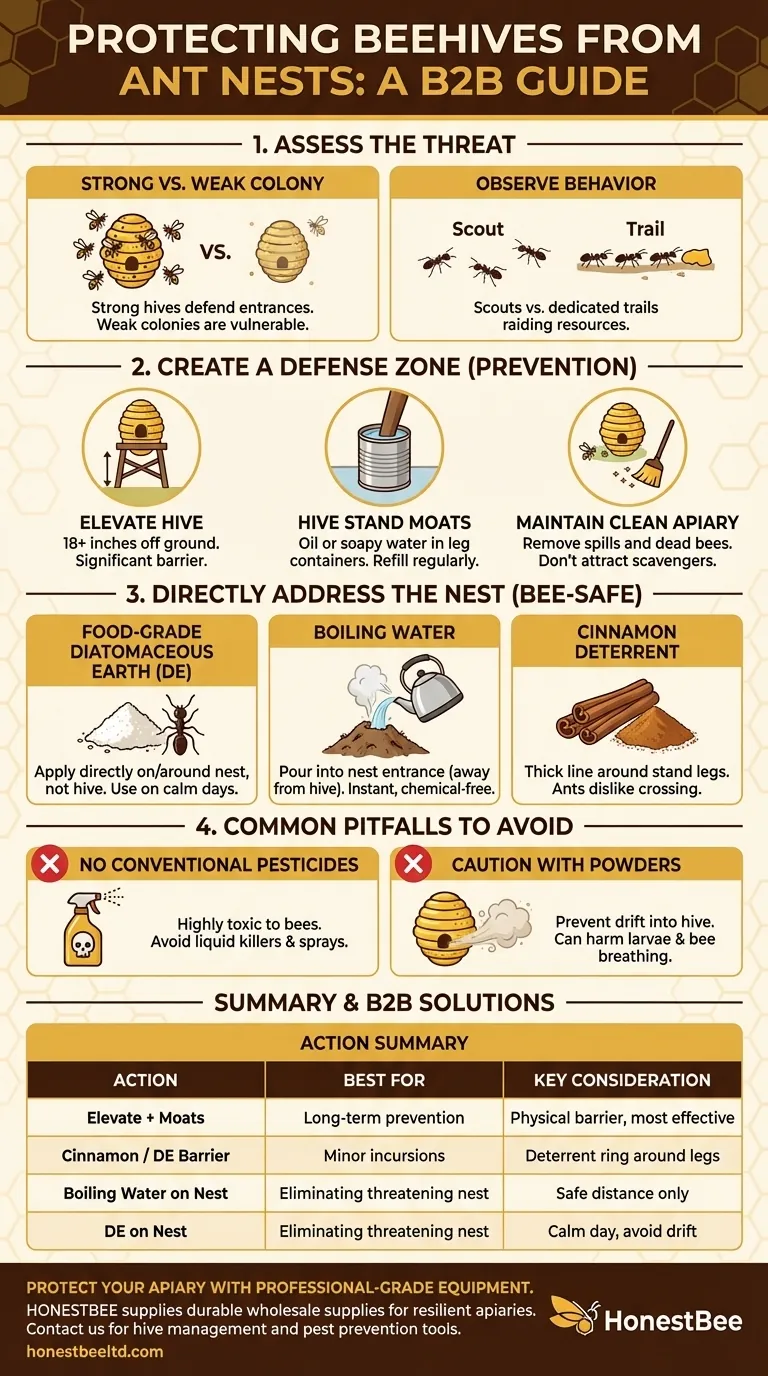
Related Products
- Wholesales Dadant Size Wooden Bee Hives for Beekeeping
- Professional Multi-Function Stainless Steel Hive Tool
- Professional Insulated Plastic Bee Hives
- Long Langstroth Style Horizontal Top Bar Hive for Wholesale
- Langstroth Bee Hives Bee Keeping Box for Beginners Beekeeping
People Also Ask
- How often should the area under beehives be inspected and cleaned during the warm season? A Proactive Maintenance Guide
- What are the characteristics of oil-based paint for beehives? Durability vs. Modern Practicality
- What are the advantages of wooden bee hives? Superior Bee Health & Beekeeper Flexibility
- What should beginners consider when purchasing beekeeping equipment? A Guide to Essential Starter Gear
- What is the best place to keep bees? Find the Perfect Apiary Site for Your Hives










